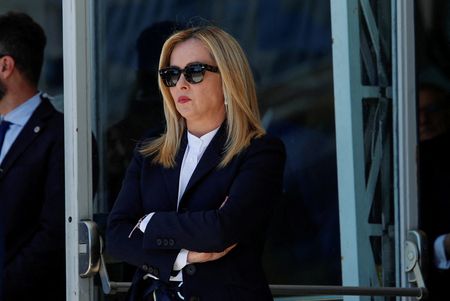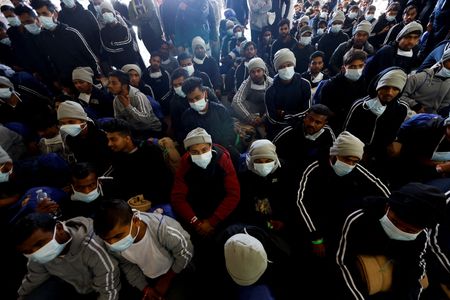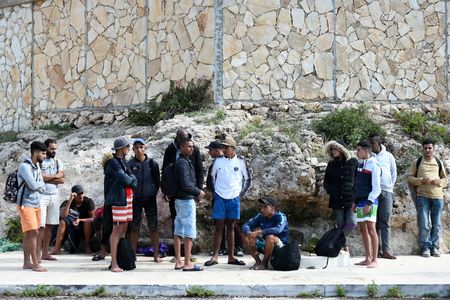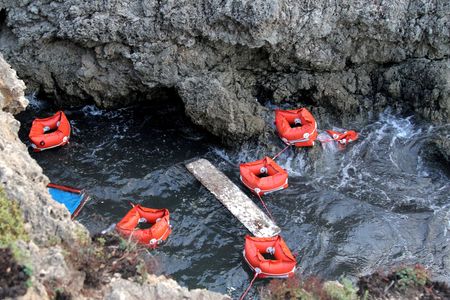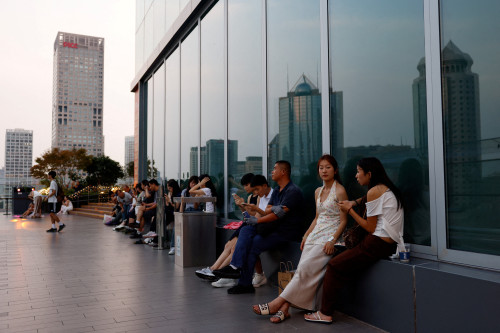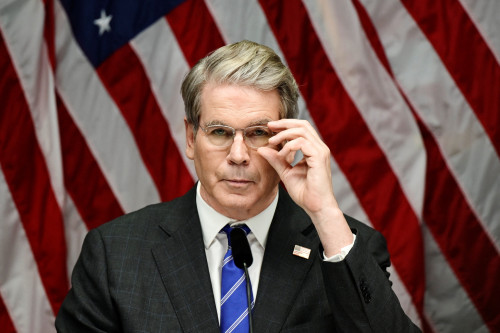By Crispian Balmer and Angelo Amante
ROME (Reuters) – Just as King Canute failed to hold back the seas, so Prime Minister Giorgia Meloni has floundered in her efforts to stop the flow of migrants to Italy since she took office last October.
Despite pledges before last year’s national election that she would cut immigration, the number of people crossing the Mediterranean in a flotilla of often decrepit old boats has doubled over the past nine months.
In addition, bowing to pressure from the business lobby, which is traditionally close to Meloni’s right-wing bloc, the government last week increased the number of migrants who can legally come to Italy for work as the population rapidly ages.
“The government is clearly not delivering what it promised, but the ruling parties are still seen by their electorate as much more reassuring than the left on immigration, so they are not feeling pressure in the opinion polls,” said Mattia Diletti, a politics professor at Rome’s Sapienza University.
Immigration is one of the biggest political issues in Europe and has played a major role in the rise of nationalist parties across the continent over the past decade. The fact that Meloni, a figurehead of the new right, has not carried through on her pledges underscores how intractable the problem is.
It isn’t for want of trying.
Since the start of 2023, Meloni has controversially limited the operations of charity rescue ships and upped penalties on people smugglers after a shipwreck off southern Italy claimed at least 94 lives in February. She subsequently declared a state of emergency over the non-stop arrival of mainly Africans.
All to no avail.
From Jan. 1 to July 12, 73,414 boat migrants reached Italy against 31,333 in the same period last year and more than for the whole of 2021, according to Interior Ministry data.
“There are no miraculous solutions to resolve the migration phenomenon,” Interior Minister Matteo Piantedosi acknowledged this month while visiting the tiny island of Lampedusa, which saw 25 separate boat landings on Tuesday alone.
NORTH AFRICA
In the run-up to the 2022 election, Meloni said she would impose a naval blockade to prevent boats leaving north Africa. But analysts say that was never going to happen for legal and ethical reasons.
Instead, Meloni has looked to revive a 2017 deal struck with Libya that led to a huge reduction in departures, until the COVID-19 pandemic, which then cut migrant flows to a trickle.
But the situation in North Africa has changed enormously over the past six years, says Matteo Villa, a senior research fellow with the ISPI think-tank, complicating efforts to hold back people looking for a better, safer life in Europe.
“The 2017 departures were super concentrated in a few places west of Tripoli. Today this is not the case. People are also leaving from eastern Libya. So who do you talk to? In 2017 Italian intelligence knew the militia, now it doesn’t,” he said.
An added complication is that Tunisia has also become a major springboard for migrants, with just over half of all new arrivals in Italy this year setting sail from there, against just 5% in 2017, despite hundreds dying in the process.
Meloni visited Tunisia twice last month, seeking progress in unblocking loans that she says are needed to avoid a financial crisis that might trigger a tsunami of departures.
She was accompanied on her second trip by European Commission President Ursula von der Leyen and Dutch Prime Minister Mark Rutte, highlighting pan-European concern at the situation in Tunisia, and the rising tide of migrant landings.
BUSINESS NEEDS
A fierce critic of Brussels before her rise to power, Meloni has been much more pragmatic since becoming prime minister, working actively with the European Commission to revise the way migrants are relocated across the continent.
The pact is expected to come into force this year, despite opposition from Rome’s right-wing allies in Poland and Hungary. However, a review of migrant flows through Europe over the past decade suggests Italy might not benefit in the way Meloni hopes.
At present many of those reaching Italy head immediately to richer northern Europe, meaning Rome has to process fewer asylum seekers than many EU partners – a figure representing 0.16% of its total population over the past 12 months against an EU average of 0.22%, according to ISPI.
“Between 2012 to 2021 one million people disembarked in Italy. We estimate that 700,000 moved on,” said ISPI’s Villa.
Many businesses could have done with that labour, a message that is getting through to the government.
Last week, it said it would issue 452,000 new work visas for non-EU nationals from 2023 to 2025, increasing the number of permits available each year to hit a high of 165,000 in 2025. In 2019, before COVID struck, Italy issued just 30,850 visas.
Looking to appease anti-immigrant supporters, the government suggested it was acting with restraint, saying companies and unions had called for 833,000 permits in the 2023-2025 period.
Business leaders welcomed the initial increase, but say more will be needed to tackle a longstanding demographic decline.
“Everyone knows by now that we have a shortage of both skilled and general labour,” said Michelangelo Agrusti, head of a Confindustria business federation in north east Italy.
(Reporting by Crispian Balmer and Angelo Amante; Editing by Alex Richardson)


